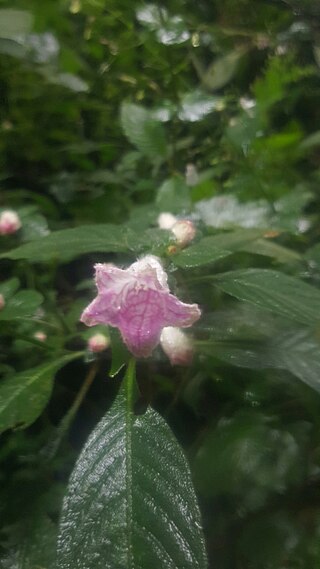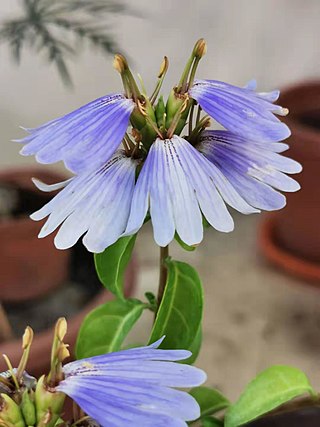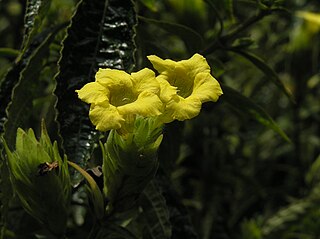
The order Lamiales are an order in the asterid group of dicotyledonous flowering plants. It includes about 23,810 species, 1,059 genera, and is divided into about 25 families. These families include Acanthaceae, Bignoniaceae, Byblidaceae, Calceolariaceae, Carlemanniaceae, Gesneriaceae, Lamiaceae, Lentibulariaceae, Linderniaceae, Martyniaceae, Mazaceae, Oleaceae, Orobanchaceae, Paulowniaceae, Pedaliaceae, Peltantheraceae, Phrymaceae, Plantaginaceae, Plocospermataceae, Schlegeliaceae, Scrophulariaceae, Stilbaceae, Tetrachondraceae, Thomandersiaceae, Verbenaceae.

Acanthaceae is a family of dicotyledonous flowering plants containing almost 250 genera and about 2500 species. Most are tropical herbs, shrubs, or twining vines; some are epiphytes. Only a few species are distributed in temperate regions. The four main centres of distribution are Indonesia and Malaysia, Africa, Brazil, and Central America. Representatives of the family can be found in nearly every habitat, including dense or open forests, scrublands, wet fields and valleys, sea coast and marine areas, swamps, and mangrove forests.

Avicennia is a genus of flowering plants currently placed in the bear's breeches family, Acanthaceae. It contains mangrove trees, which occur in the intertidal zones of estuarine areas and are characterized by its "pencil roots", which are aerial roots. They are also commonly known as api api, which in the Malay language means "fires", a reference to the fact that fireflies often congregate on these trees. Species of Avicennia occur worldwide south of the Tropic of Cancer.

Acanthus is a genus of about 30 species of flowering plants in the family Acanthaceae, native to tropical and warm temperate regions, with the highest species diversity in the Mediterranean Basin and Asia. This flowering plant is nectar-producing and depends on butterflies, such as Anartia fatima, and other nectar-feeding organisms to distribute its pollen. Common names include Acanthus and bear's breeches. The generic name derives from the Greek term ἄκανθος (akanthos) for Acanthus mollis, a plant that was commonly imitated in Corinthian capitals.
Justicia chrysotrichoma is a species of flowering plant in the family Acanthaceae. It is native to the Cerrado ecoregion of central Brazil.

Staurogyne is a genus of plants in the family Acanthaceae.

Suessenguthia is a genus of the Acanthaceae plant family comprising eight species of shrubs with showy, tubular flowers arranged in few-flowered heads. It occurs in the lowlands and Andean foothills of southern Peru, Bolivia, and the Brazilian state of Acre, often growing in small groups along rivers.

Thomandersia is the sole genus in the Thomandersiaceae, an African family of flowering plants. Thomandersia is a genus of shrubs and small trees, with six species native to Central and West Africa.

Acanthopale is a plant genus of shrubs or subshrubs in the Acanthaceae plant family. The genus name is based on the classic Greek words for thorn ákantha and stake palum. Some species in the genus are cultivated as ornamental plants.

Anisotes is a genus of Afrotropical plants in the family Acanthaceae. The genus is morphologically similar to Metarungia, from which it differs mainly in the dehiscence of the fruit capsule, and the nature of the placenta. Placentas remain attached to the inner surface of fruit capsules in Anisotes.

Sclerochiton is a genus of flowering plants in the family Acanthaceae. It includes 18 species native to tropical and southern Africa.

Strobilanthes crispa is a shrub which originated from Madagascar, and is now found across south east Asia. It is a member of the family Acanthaceae. It is known as pokok pecah kaca or pokok pecah beling in Malaysia, and pecah beling, enyoh kilo, kecibeling or kejibeling in Indonesia. The leaves are used traditionally for treatment of cancer and diabetes, usually taken as a tea or infusion of the leaves.

Thunbergia erecta, commonly known as the bush clock vine or king's mantle, is a vibrant, evergreen species of shrub in the family Acanthaceae. Native to the forest zone stretching from Guinea-Bissau to western Cameroon, it has found significant cultivation worldwide due to its ornamental appeal and versatility. The plant is particularly known for its erect or scandent growth habit, reaching a notable height of up to five meters or more. This robust shrub displays a fascinating range of pale to dark violet-purple flowers that contribute to its visual appeal and broad popularity. Each flower measures between 5.0 to 7.5 cm in length, hosting a stark white tube at their core. This striking color contrast lends an undeniable charm to the plant, making it a favored choice in various garden settings and landscapes.
Cornelis Eliza Bertus Bremekamp was a Dutch botanist.
Metarungia galpinii is a species of flowering plant in the family Acanthaceae of dicotyledonous flowering plants. It is a shrub endemic to the Eastern Cape Province of South Africa. It is the sole species in genus Metarungia.

Dicliptera tinctoria is the accepted name of a species in the family Acanthaceae. It may be called magenta plant, or lá cẩm in Vietnamese and native to southeastern Asia from Assam south to Sri Lanka and east to mainland Southeast Asia, Java, southern China, and Taiwan.
Thomas Franklin Daniel is an American botanist, and teacher. He is a specialist of the botanical family Acanthaceae. In 1975 he obtained his undergraduate from Duke University. In 1980, he obtained his doctorate at the University of Michigan. In 1981, he was assistant professor. Between 1981 and 1985 he was an assistant curator of the Arizona State University Herbarium.
Calycacanthus magnusianus is a species of flowering plant belonging to the family Acanthaceae. It is endemic to New Guinea. It is the sole species in genus Calycacanthus.
Rhaphidospora is a genus of flowering plants belonging to the family Acanthaceae. A classification of the Acanthaceae published in 2022 treats Rhaphidospora as a synonym of Justicia.












